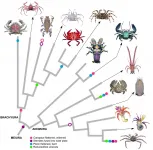RNA editing protein ADAR1 protects telomeres and supports proliferation in cancer cells
Isoform preserves telomere stability by preventing accumulation of R-loops, emerging as a new cancer cell vulnerability that could be therapeutically targeted.
2021-03-12
(Press-News.org) PHILADELPHIA -- (March 12, 2021) -- Scientists at The Wistar Institute identified a new function of ADAR1, a protein responsible for RNA editing, discovering that the ADAR1p110 isoform regulates genome stability at chromosome ends and is required for continued proliferation of cancer cells. These findings, reported in Nature Communications, reveal an additional oncogenic function of ADAR1 and reaffirm its potential as a therapeutic target in cancer.
The lab of Kazuko Nishikura, Ph.D., professor in the Gene Expression & Regulation Program of The Wistar Institute Cancer Center, was one of the first to discover ADAR1 in mammalian cells and to characterize the process of RNA editing and its multiple functions in the cell.
Similar to changing one or more letters in a written word, RNA editing allows cells to make discrete modifications to single nucleotides within an RNA molecule. This process can affect RNA metabolism and how it is translated into proteins and has implications for neurological and developmental disorders and antitumor immunity.
There are two forms of the ADAR1 protein, ADAR1p150 and ADAR1p110. While the RNA editing role of the former, located in the cytoplasm, has been extensively characterized, the function of the nuclear ADAR1p110 isoform remained elusive.
"We discovered that in the nucleus, ADAR1p110 oversees a similar mechanism to ADAR1p150, the better-known cytoplasmic variant, but the editing process in this case targets particular nucleic acid structures called R-loops when formed at the chromosome ends," said Nishikura. "Through this function, ADAR1p110 seems to be essential for cancer cell proliferation."
R-loops form during gene transcription when, instead of dissociating from its template DNA strand, the newly synthesized RNA remains attached to it, leading to a stable DNA/RNA hybrid. While these structures can be beneficial for transcriptional regulation in certain conditions, accumulation of R-loops can cause DNA damage, chromosome rearrangements and genomic instability and is linked to neurological disorders and cancer.
Nishikura and colleagues found that ADAR1p110 helps the cells resolve R-loops and prevent their accumulation by editing both the DNA and the RNA strands involved in the structure and facilitating degradation of the RNA strand by the RNase H2 enzyme.
Notably, researchers found that ADAR1p110 depletion results in accumulation of R-loops at the chromosome ends, indicating that ADAR1p110 acts on R-loops formed in the telomeric regions and is required to preserve telomere stability.
Telomeres serve as an internal clock that tells normal cells when it's time to stop proliferating. Just like the plastic coating on the tips of shoelaces, telomeres protect chromosome ends from the loss of genetic material at each cell division, by their progressive shortening eventually triggers growth arrest or cell death.
Cancer cells bypass this mechanism to become immortal. Researchers found that ADAR1p110 depletion leads to extensive telomeric DNA damage and arrested proliferation specifically in cancer cells.
"It has recently been suggested ADAR1 inhibitors could potentiate tumor response to immunotherapy by interfering with certain cytoplasmic ADAR1p150 functions," said Nishikura. "Based on our findings on the role of nuclear ADAR1p110 in maintaining telomere stability in cancer cells, we predict that ADAR1 inhibitors would be very effective anticancer therapeutics by interfering with two different and independent pro-oncogenic ADAR1functions exerted by the two isoforms."
INFORMATION:
Co-authors: Yusuke Shiromoto*, Masayuki Sakurai*, Moeko Minakuchi*, and Kentaro Ariyoshi from The Wistar Institute. *Co-first authors.
Work supported by: National Institutes of Health (NIH) grants GM040536, CA175058, and GM130716; additional support was provided by the Emerson Collective, the Japan Society for the Promotion of Science (JSPS), and the Uehara Memorial Foundation. Core support for The Wistar Institute was provided by the Cancer Center Support Grant P30CA010815.
Publication information: ADAR1 RNA editing enzyme regulates R-loop formation and genome stability at telomeres in cancer cells, Nature Communications, 2021. Online publication.
The Wistar Institute is an international leader in biomedical research with special expertise in cancer research and vaccine development. Founded in 1892 as the first independent nonprofit biomedical research institute in the United States, Wistar has held the prestigious Cancer Center designation from the National Cancer Institute since 1972. The Institute works actively to ensure that research advances move from the laboratory to the clinic as quickly as possible. wistar.org.
[Attachments] See images for this press release:

ELSE PRESS RELEASES FROM THIS DATE:
2021-03-12
A factor that turns malignant tumors into benign ones? - That is exactly what scientists at St. Anna Children's Cancer Research Institute have discovered. Together with colleagues from the Medical University of Vienna and the University of Vienna (Faculty of Chemistry), they studied tumors of the peripheral nervous system in children, namely neuroblastomas. The scientists discovered that the uncontrolled growth of benign neuroblastomas is stopped by a signal molecule produced by Schwann cells present within these tumors. This natural "brake" also works on malignant neuroblastoma ...
2021-03-12
Brominated flame retardants (BFRs) are found in furniture, electronics, and kitchenware to slow the spread of flames in the event of a fire. However, it has been shown that these molecules may lead to early mammary gland development, which is linked to an increased risk of breast cancer. The study on the subject by Professor Isabelle Plante from the Institut national de la recherche scientifique (INRS) made the cover of the February issue of the journal Toxicological Sciences.
Part of the flame retardants are considered to be endocrine disruptors, i.e. they interfere with the hormonal system. Since they are not directly bound to the material in which they are added, the molecules escape easily. They are then found in house ...
2021-03-12
Chest pain is misdiagnosed in women more frequently than in men, according to research presented today at ESC Acute CardioVascular Care 2021, an online scientific congress of the European Society of Cardiology (ESC).1 The study also found that women with chest pain were more likely than men to wait over 12 hours before seeking medical help.
"Our findings suggest a gender gap in the first evaluation of chest pain, with the likelihood of heart attack being underestimated in women," said study author Dr. Gemma Martinez-Nadal of the Hospital Clinic of Barcelona, Spain. "The low suspicion of heart attack occurs in both women themselves and in physicians, leading to higher risks of late diagnosis and misdiagnosis."
This study examined gender differences in the presentation, ...
2021-03-11
As gatherings to observe whooping cranes join the ranks of online-only events this year, a new study offers insight into how the endangered bird is faring on a landscape increasingly dotted with wind turbines. The paper, published this week in Ecological Applications, reports that whooping cranes migrating through the U.S. Great Plains avoid "rest stop" sites that are within 5 km of wind-energy infrastructure.
Avoidance of wind turbines can decrease collision mortality for birds, but can also make it more difficult and time-consuming for migrating flocks to find safe and suitable rest and refueling locations. The study's insights into migratory behavior ...
2021-03-11
COLUMBUS, Ohio - Overweight low-income mothers of young kids ate fewer fast-food meals and high-fat snacks after participating in a study - not because researchers told them what not to eat, but because the lifestyle intervention being evaluated helped lower the moms' stress, research suggests.
The 16-week program was aimed at preventing weight gain by promoting stress management, healthy eating and physical activity. The methods to get there were simple steps tucked into lessons on time management and prioritizing, many demonstrated in a series ...
2021-03-11
In the field of robotics, metals offer advantages like strength, durability, and electrical conductivity. But, they are heavy and rigid--properties that are undesirable in soft and flexible systems for wearable computing and human-machine interfaces.
Hydrogels, on the other hand, are lightweight, stretchable, and biocompatible, making them excellent materials for contact lenses and tissue engineering scaffolding. They are, however, poor at conducting electricity, which is needed for digital circuits and bioelectronics applications.
Researchers in Carnegie Mellon University's Soft Machines Lab have developed a unique silver-hydrogel composite that has high electrical ...
2021-03-11
Crabs are living the meme life on social media lately. The memes joke that everything will eventually look like a crab. But it's actually based in some truth.
The crab shape has evolved so many times the evolutionary biologist L.A. Borradaile coined the term carcinization in 1916 to describe the convergent evolution process in which a crustacean evolves into a crab-like form from a non-crab-like form. Crabs are decapod crustaceans of the infraorder Brachyura and are considered "true crabs", most of which are carcinized. "False crabs" are of the ...
2021-03-11
As experts nationwide point to a mental health crisis among teens and young adults, a pilot program teaching mindfulness and coping techniques to students at the University of Washington has helped lower stress and improve emotional well-being.
New studies by the psychology researchers who created the program find that the strategies, offered first in residence halls and later through classes and other organized campus groups, have provided participants with successful methods for coping with stress, managing their emotions and learning self-compassion.
Researchers say the results show the potential for preventive mental health services offered in an accessible, peer-group environment.
"This program is not a substitute ...
2021-03-11
In Brazil, a study conducted by researchers affiliated with the University of São Paulo (USP) and collaborators showed that deforestation in the Amazon causes an increase in the diversity of antibiotic-resistant bacteria. An article on the study, published in Soil Biology and Biochemistry, compares the microorganisms that live in the soil of native forest with those found in pasture and croplands. The researchers found a far larger number of genes considered markers of antibiotic resistance in deforested than forested areas.
“Bacteria produce substances with which to attack each other in a competition for resources that’s ...
2021-03-11
URBANA, Ill. ¬- As the global population grows, the demand for food increases while arable land shrinks. A new University of Illinois study investigates how rice production in India can meet future needs by adapting to changing climate conditions and water availability.
"Rice is the primary crop in India, China, and other countries in Southeast Asia. Rice consumption is also growing in the U.S. and elsewhere in the world," says Prasanta Kalita, professor in the Department of Agricultural and Biological Engineering at U of I and lead author on the study.
"If you look at where they traditionally grow rice, it is countries that have ...
LAST 30 PRESS RELEASES:
[Press-News.org] RNA editing protein ADAR1 protects telomeres and supports proliferation in cancer cells
Isoform preserves telomere stability by preventing accumulation of R-loops, emerging as a new cancer cell vulnerability that could be therapeutically targeted.







